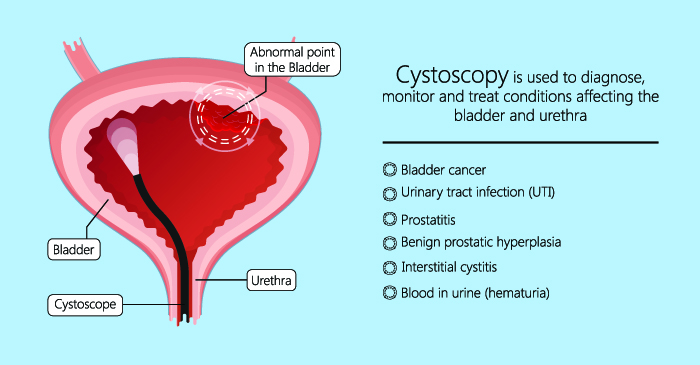Cystoscopy Treatment Treatment & Diagnostics in Karol Bagh, Delhi
Cystoscopy Treatment
Cystoscopy is a process during which your doctor or a urinary tract specialist will use a scope to view the inner areas of the bladder and the urethra. It is used for diagnosis as well as treatment of the problems related to your urinary tract.
Issues related to the urinary bladder include bladder cancer, urinary tract infections and bladder control problems.
For the procedure, a urologist uses a small device called a cystoscope, which is a small and thin light tube with a lens or a camera.
To know more, consult a urology doctor near you. Or visit a urology hospital near you.

What is cystoscopy?
It is a process during which a doctor examines the linings of the bladder and the urethra, a thin tube that dispenses urine from your body. In this method, the thin, hollow tube with the lens will be put inside your urethra, and it slowly moves up to your bladder.
When do you need to see a doctor?
You need to consult your doctor immediately or go to the nearest hospital if you observe the following:
- You are unable to urinate after cystoscopy
- You notice bright red or heavy blood clots in urine
- Experience abdominal pain and feel nauseous
- Feel extremely cold
- Run a high fever
- Feel a burning sensation during urination after cystoscopy
Request an appointment at Apollo Spectra Hospitals, Karol Bagh, New Delhi.
Call 1860 500 2244 to book an appointment.
Why is cystoscopy done?
The primary goal is to diagnose, monitor and treat any condition that may affect your bladder or urethra. The process is recommended in the following conditions:
- To observe signs and symptoms - There can be numerous symptoms that can help in determining urological health conditions. Some of them are blood spots in urine, pain in urination, overactive bladder, incontinence, etc. Cystoscopy can help understand the cause of frequent infection of the urinary tract.
- Diagnosis of disease related to the bladder - It may include bladder stones, bladder cancer or inflammation of your bladder.
Doctors use very few tools in cystoscopy. Doctors can remove a very small tumor in the bladder during cystoscopy.
The process can be used:
- To get your urine sample from the ureter
- For injecting dye to do an X-ray test for tracking urine
- To inject dye in the event of involuntary bladder movement
- For removing a stent from the urethra that was placed during an earlier process
- To take out bladder stones, tumors, polyps or abnormal tissue
- For taking a small piece of your bladder or urethral tissue for a procedure like a biopsy or examination in a lab
- For treatment of urethral strictures or fistulas
How is cystoscopy done?
The cystoscopy procedure may make you feel uncomfortable. Hence, your doctor will give you anesthesia to avoid the pain. The cystoscopy for diagnosis only takes around five to ten minutes. In case of a biopsy, it can take longer.
Your doctor will follow the following steps:
- The doctor will lubricate the cystoscope and slide it into your urethra up to the bladder.
- Then they will inject sterile water with the assistance of the cystoscope into the bladder. When the bladder is stretched, it is easier to observe the bladder lining.
- The doctor will be screening the insides of your bladder and urethra.
- They will also insert tiny instruments through the cystoscope to remove a small tissue sample or tumor.
- They will drain the liquid injected into your bladder and will ask you to empty the bladder in a toilet.
There can be numerous after-effects of undergoing the cystoscopy process. You may experience chest pain or spots of blood in urine. You can also feel a slight discomfort while peeing and may want to pee frequently. But the signs usually fade after 1-2 days.
The doctor will give you antibiotics, but you can also use the following to alleviate the pain:
- Take a damp cloth and apply it to the urethral opening or you can take a warm bath.
- You need to drink plenty of fluids to flush out your bladder.
- In extreme cases, take a dull pain relieving medicine.
What are the risks?
Some potential risks include:
- There can be an infection in the bladder, which may cause painful cramps and urine leaking.
- There can be scarring or narrowing of the urethra, which may be due to trauma.
- Chances of UTI are quite high.
It is usually not painful, but you need to inform your doctor if you feel any pain during the procedure.
Cystoscopy can assist in observing issues in the urinary tract, including early symptoms of cancer, bleeding, narrowing, blockage or infection.
There are no authentic alternatives to the process of cystoscopy.
Our Top Specialities
NOTICE BOARD
CONTACT US
CONTACT US
 Book Appointment
Book Appointment


.svg)
.svg)
.svg)
.svg)








